- Table of Content
- 1.Happy Birthday...
- 2.Space Weather ...
- 3.Space Weather ...
- 4.PROBA2 Observa...
- 5.The Internatio...
- 6.Geomagnetic Ob...
- 7.Review of iono...
- 8.New documents ...
- 9.Future Events
2. Space Weather - Belgian wins an award
3. Space Weather review in oral format
4. PROBA2 Observations (23 Nov 2015 - 29 Nov 2015)
5. The International Sunspot Number
6. Geomagnetic Observations at Dourbes (23 Nov 2015 - 29 Nov 2015)
7. Review of ionospheric activity (23 Nov 2015 - 29 Nov 2015)
8. New documents in the European Space Weather Portal Repository
9. Future Events
Happy Birthday SOHO!
On 02 December 2015, the Solar and Heliospheric Observatory (SOHO ; http://sohowww.nascom.nasa.gov/) will celebrate its 20th birthday. Since its launch in 1995, this versatile spacecraft has become an icon in solar and heliospheric research, and has provided space weather forecasters a solid base to build on.
SOHO, a combined ESA/NASA project, revolutionized space weather monitoring by providing imagery of the Sun in white light, 4 wavelengths in extreme ultraviolet, and magnetograms at a cadence of several images per hour. Its coronagraphs provided a view of the immediate surroundings of the Sun, allowing a good view on the dreaded coronal mass ejections. More importantly, these images were available in near real-time, something unseen up to that time.
SOHO instruments have contributed to several other research domains, such as the solar wind (parameters, origin) or the solar interior (oscillations). The spacecraft is also the best comet chaser in history, having made its 3000th (three thousand!) comet discovery just a few months ago (13 September 2015).
SOHO had a near-death experience in 1998 after a loss of control on 24 June. Fortunately, ground controllers heroically regained contact with and control of the spacecraft over the next few months. It's the single period in SOHO's operational life without imagery, and it became known as "SOHO's holiday". Eventually, this workhorse of the solar scientists and space weather specialists would become superseded by the Solar Dynamics Observatory in 2010, which had a much higher resolution and image cadence. However, the telemetry gained by stopping SOHO's solar disk imagery was used to boost the cadence of the coronagraphic images to one image every 12 minutes, for both coronagraphs. That is why, up to this day, SOHO remains the main spacecraft delivering the so critical coronagraphic imagery.
The movie at https://youtu.be/GrUqcyPerXI is a small selection of the most spectacular events observed by SOHO. More information, imagery, contests,... can be found on the website at http://sohowww.nascom.nasa.gov/ . Many congratulations to the SOHO team and all who contributed to this ongoing and incredibly successful solar mission!
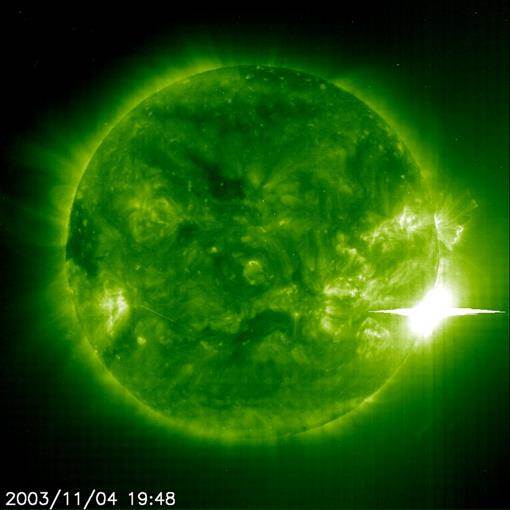
Space Weather - Belgian wins an award
Since 2013, space weather medals are awarded at the annual European Space Weather Week conference. This year Dr. David Berghmans, a Belgian scientist at the Royal Observatory of Belgium, won the Marcel Nicolet medaille for his efforts to structure the space weather community at an international level.
The study of space weather is a young scientific discipline with increasing importance due to the impact solar storms can have on our high-technological society.
David Berghmans stood at the cradle of the space weather program in Belgium and Europe. The study of space weather received a boost in the nineties from the joint ESA/NASA space mission Solar and Heliospheric Observatory (SOHO) to which Belgium contributed substantially with the EIT telescope. In the year 2000, David Berghmans created a Belgian Space Weather Center combining fundamental and applied research, which paved the road to space weather services and predictions up to a few days in the future. The center is one of the cornerstones of a worldwide network. This success story continues in the form of participation in numerous other space weather projects of the 21st century.
Thanks to David Berghmans and his team, Belgium now occupies a prominent place on the space weather map.
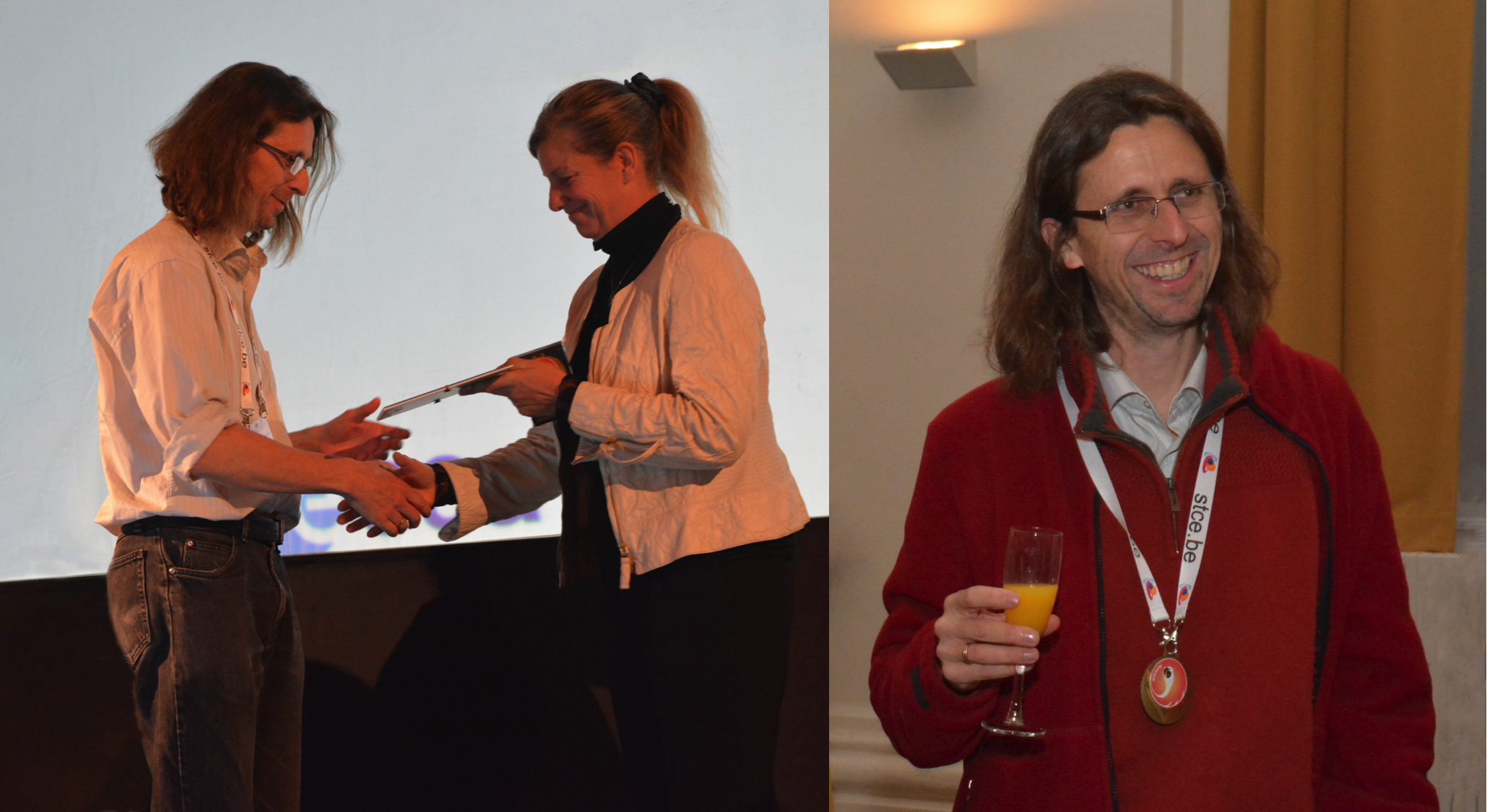
More on why Dr. Berghmans and his team won: http://www.stce.be/press/04/Berghmans.pdf
More on the medals: http://www.stce.be/esww12/medals.php
Space Weather review in oral format
What is the probability a solar storm will occur? - Will the solar panels of satellites in a geostationary orbit be damaged? - Can the Sun cause radar blackouts disrupting air traffic?
Effective and reliable space weather services and space-weather-proof software and hardware are part of the solution towards a resilient society. From this perspective, daily space weather bulletins are indeed broadcasted by forecast centers worldwide.
Four excellent television bulletins on the solar and geomagnetic activity from 23-29 November were served by a Belgian, 2 British and an American space weather service center at the annual European Space Weather Week: http://www.stce.be/esww12/liveforecast.php
Nothing better and easier than a space weather expert explaining you what happened the previous days and what we are heading to. Lean back and enjoy!
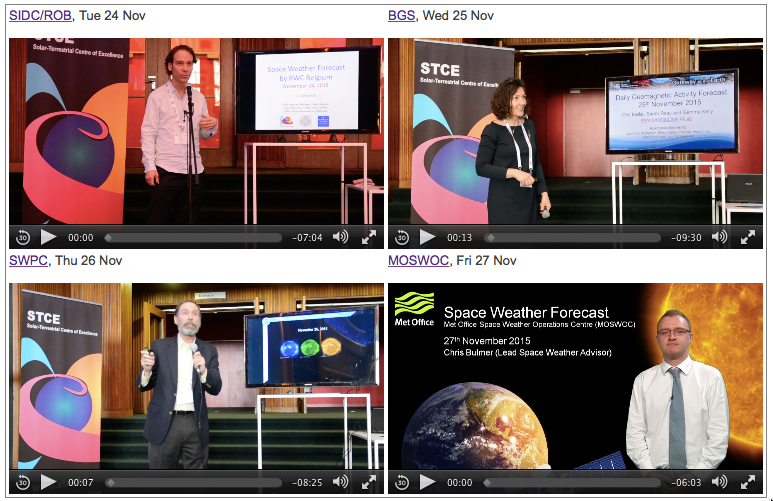
PROBA2 Observations (23 Nov 2015 - 29 Nov 2015)
Solar Activity
Solar flare activity fluctuated between very low and low during the week.
In order to view the activity of this week in more detail, we suggest to go to the following website from which all the daily (normal and difference) movies can be accessed:
http://proba2.oma.be/ssa
This page also lists the recorded flaring events.
A weekly overview movie can be found here (SWAP week 296).
http://proba2.oma.be/swap/data/mpg/movies/weekly_movies/weekly_movie_2015_11_23.mp4
Details about some of this week’s events, can be found further below.
Wednesday Nov 25
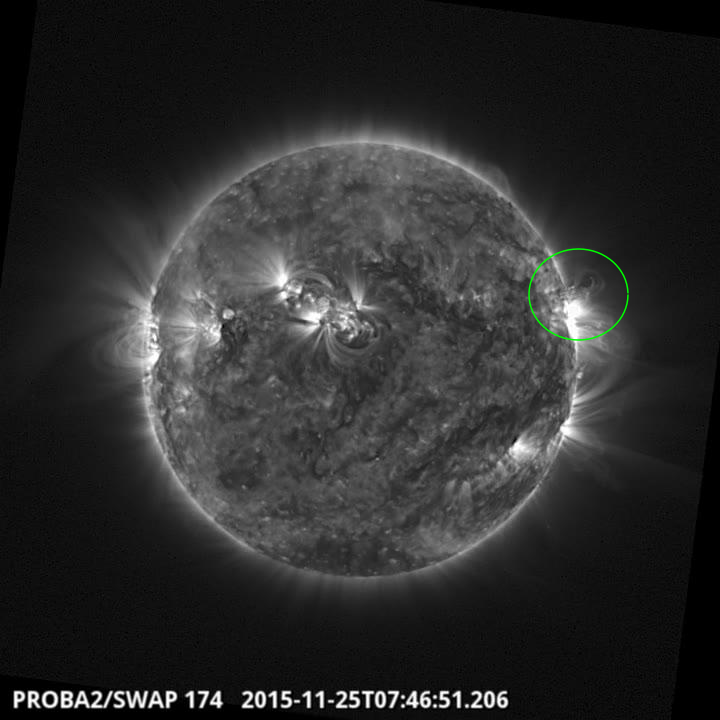
Plasma dynamics @ 07:46 SWAP image
Find a movie of the event here (SWAP movie)
http://proba2.oma.be/swap/data/mpg/movies/20151125_swap_movie.mp4
The International Sunspot Number
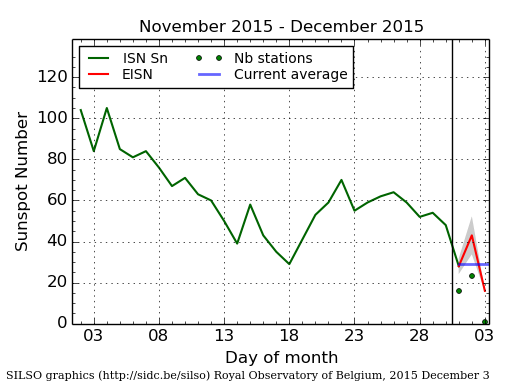
The daily Estimated International Sunspot Number (EISN, red curve with shaded error) derived by a simplified method from real-time data from the worldwide SILSO network. It extends the official Sunspot Number from the full processing of the preceding month (green line). The plot shows the last 30 days (~ one solar rotation). The horizontal blue line shows the current monthly average, while the green dots give the number of stations included in the calculation of the EISN for each day.
Review of ionospheric activity (23 Nov 2015 - 29 Nov 2015)
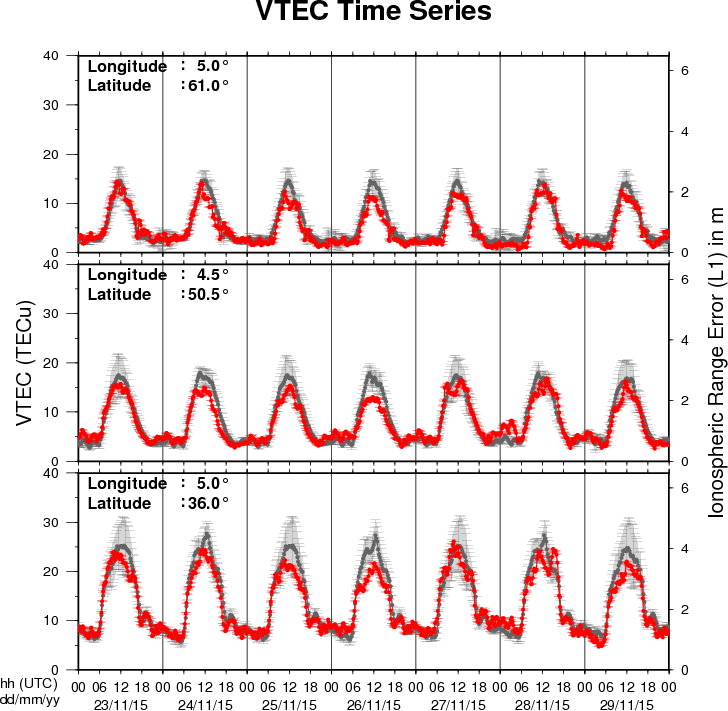
The figure shows the time evolution of the Vertical Total Electron Content (VTEC) (in red) during the last week at three locations:
a) in the northern part of Europe(N61°, 5°E)
b) above Brussels(N50.5°, 4.5°E)
c) in the southern part of Europe(N36°, 5°E)
This figure also shows (in grey) the normal ionospheric behaviour expected based on the median VTEC from the 15 previous days.
The VTEC is expressed in TECu (with TECu=10^16 electrons per square meter) and is directly related to the signal propagation delay due to the ionosphere (in figure: delay on GPS L1 frequency).
The Sun's radiation ionizes the Earth's upper atmosphere, the ionosphere, located from about 60km to 1000km above the Earth's surface.The ionization process in the ionosphere produces ions and free electrons. These electrons perturb the propagation of the GNSS (Global Navigation Satellite System) signals by inducing a so-called ionospheric delay.
See http://stce.be/newsletter/GNSS_final.pdf for some more explanations ; for detailed information, see http://gnss.be/ionosphere_tutorial.php
New documents in the European Space Weather Portal Repository
See http://www.spaceweather.eu/en/repository
STCE - De kunst van het zonnewaarnemen
Lecture for amateur astronomers during an astronomy course at public observatory MIRA. Basics on solar observations in white light and H-alpha (instruments, filters, solar features,...). 30 attendees. 15 April 2015.
http://www.spaceweather.eu/en/repository/show?id=592
STCE - De nieuwe kleren van het zonnevlekkengetal
Overview of the sunspot number modifications introduced on 01 July 2015. What is the sunspot number, history, changes and source of modifications, consequences. Presented at the annual meeting of the Dutch Solar Section in Sonnenborgh, Utrecht, The Netherlands on 03 October 2015. 15 attendees.
http://www.spaceweather.eu/en/repository/show?id=593
STCE - Het SIDC: de voorspelling van het ruimteweer
Presentation during the symposium of the "Nederlandse Vereniging ter Bevordering van de Meteorologie" in Wageningen, the Netherlands, on 20 November 2015. Concerns a brief introduction on space weather, followed by what the SIDC is and how it provides the space weather forecasts. Addresses tools and methodology. 60 attendees.
http://www.spaceweather.eu/en/repository/show?id=594
ESWW12 - Space weather predictions for space missions
Lecture given during the Tutorial of the ESWW12 on 23 November 2015 in Oostende, Belgium. Addresses the GAIA, Venus Express and Rosetta missions and how the SIDC and SSCC provided the tailored space weather forecasts for these missions. 4 groups of about 25 participants.
http://www.spaceweather.eu/en/repository/show?id=595
STCE - The Editorial Office of the SWSC Journal: an inside look
This lecture was given in the framework of regular seminars held at the Space Pole. It concerned the role of the editorial office in the SWSC Journal, its various tasks, the review process, and the daily management. 23 October 2015. 15 attendees.
http://www.spaceweather.eu/en/repository/show?id=596
STCE - Le Soleil et la météo de l'espace
Presentation given during the Belgian Solar Observing Day on 05 July 2015 at the Planetarium, Brussels, Belgium. Concerns the very basics of basics of solar activity and space weather for a broad audience. Also available in Dutch. 2 groups NL, 2 groups FR. 15 attendees.
http://www.spaceweather.eu/en/repository/show?id=597
Future Events
For more details, see http://www.spaceweather.eu/en/event/future
COSPAR/ILWS workshop: science for space weather in Goa, India
Start : 2016-01-24 - End : 2016-01-29
Understanding and being able to forecast space weather is an
increasingly important aspect of our modern technology-reliant
society. This workshop will treat all aspects of space weather,
ranging from solar origins of transient events (CMEs, Flares, CIRs)
to their propagation through the heliosphere and effects on Earth
and planetary bodies, from particle energization to forecasting
particle environment and its effects on technological and
biological systems, as well as solar-cycle effects and coupling of
space weather to atmospheric response. Metrics to assess
predictions will also be discussed. The workshop is structured
along the lines of the COSPAR space weather pathways and will
include invited, contributed talks and posters, as well as panel
discussions and tutorials.
Website:
http://www.cessi.in/ssw/program.html
The Scientific Foundation of Space Weather
Start : 2016-06-27 - End : 2016-07-01
Website:
http://www.issibern.ch/program/workshops.html
